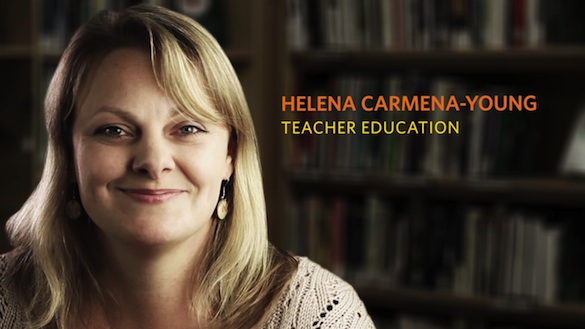Teaching Teachers About Earthquakes
Helena Carmena-Young, the Academy’s senior manager of teacher education, is in the midst of a presentation in the third-floor Education Lab. This is where Carmena-Young more commonly leads monthly professional development workshops for Bay Area teachers. Today, she is explaining how materials created in-house for the Earthquake exhibit and planetarium show will be made available online to Bay Area educators.

Carmena-Young prepares the launch of the Academy's first coursework offering on iTunes University.
"We're partnering with KQED to launch a new educational course on iTunes University," Carmena-Young says, “starting with our new Earthquake materials.” Maybe it’s her background as a middle-school science teacher, but it’s not long before Carmena-Young jumps up from her computer to start diagraming her program on the whiteboard.
“We are going to help teachers and students visualize complex geology concepts,” Carmena-Young says, “and we’re going to use these visually simulating digital assets to do it.” She is pointing to the boxes she’s drawn labeled planetarium vignettes, infographics, specimen photos, and online games. “Teachers are starving for resources,” she says. “This is going to be eye candy for them.”
The field of education is changing, Carmena-Young explains, with more people demanding access to high-quality information and self-paced learning environments. “We want to be part of this evolution,” she says. “Our enduring goal is to extend the museum-going experience and export the Academy’s expertise outside of these walls.”
While the Academy has already made its videos and podcasts available for free on iTunesU, Carmena-Young is spearheading the effort to place Earthquake-related course work, classroom activities, and student-friendly digital assets directly into the hands of teachers to use in the classroom.
The new iTunes University course will feature a five-chapter syllabus on plate tectonics, zeroing in on geology, the Bay Area’s history of seismic shocks, preparedness, including a section on the new Bay Bridge from KQED. It will also feature snippets from the new Planetarium show, activities for engagement, vocabulary, and interactive content.
This month, Carmena-Young and her colleagues in Student Education are planning special testing sessions with selected teachers and students to experience the online course, preview the exhibit, and provide feedback. This enables the Academy’s education department to fine-tune the course offering in time for its public launch on August 15 when Carmena-Young is hosting a earthquake educator preview open to all registered Bay Area teachers.
“This is a pilot program,” Carmena-Young adds. “Online coursework enables us to curate the information into a valuable learning experience and present these materials in a meaningful, accessible way.”
—Barbara Tannenbaum